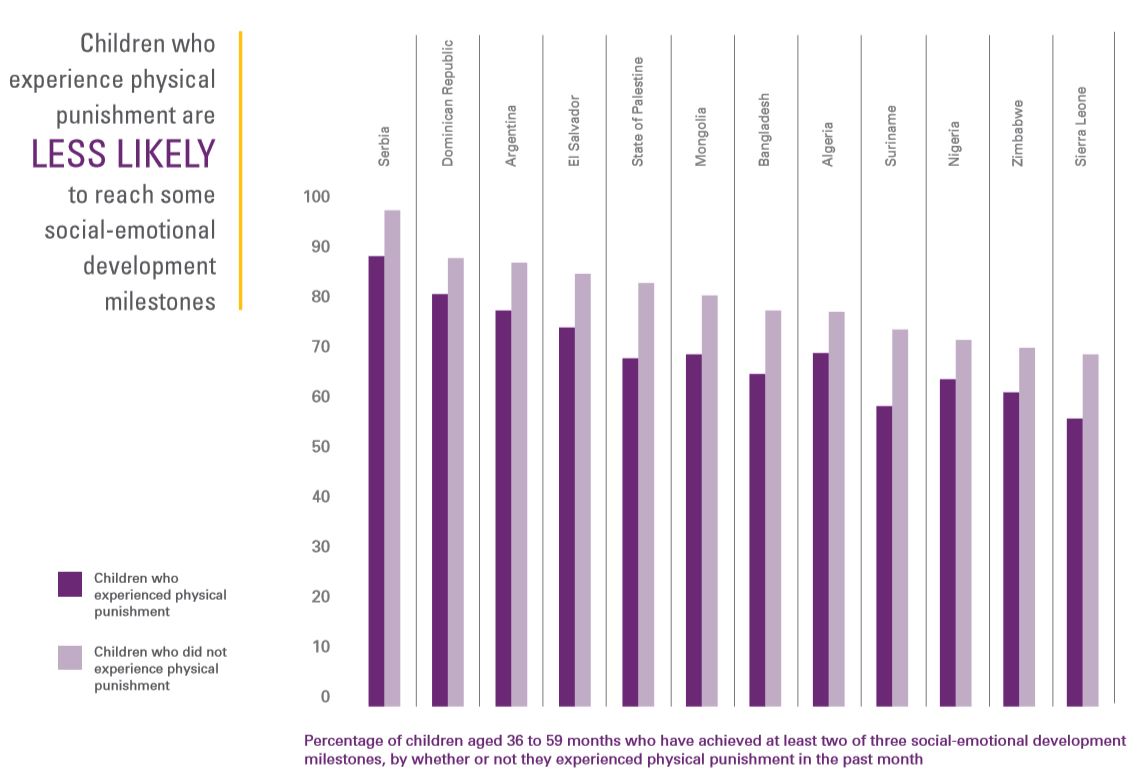This module is a resource for lecturers
Topic two - The impact of violence on children
Violence, neglect, and trauma bear detrimental impact on a child's development. Recent studies have also shown that violence and neglect can physiologically affect the development of a child's brain (UNICEF, 2017). Lifelong adverse health, social, and economic consequences exist for those affected by violence, including: mental and physical health conditions; increased health and other risk behaviours; exposure to further violence; disability from physical injury; reduced health-related quality of life; lower educational attainment; and lower levels of adult economic well-being.
For example, the following chart from UNICEF (2017, p. 24) illustrates the impact of violence on a child's emotional development. The form of violence in this case is physical discipline.
Figure 3: Physical punishment and developmental milestones among children aged 46 to 59 months
Source: UNICEF (2017). A Familiar Face: Violence in the lives of children and adolescents . New York: UNICEF, p. 24.
Violence against children is often traumatic. Abuse and neglect have an impact on a child's emotional development, social functioning and academic performance and all these effects can lead to problematic behaviour. Emotional and physical abuse and neglect can lead to affect dysregulation, hyper-arousal, and dissociation. The experience of abuse or neglect can reduce the child's cognitive capacity and cause sleep disturbance, memory difficulties and language development delays which, in turn, hinder the child's progress in school and social adaptation. Developmental trauma results from exposure to early ongoing or repetitive trauma (as infants, children and youth) linked to neglect, abandonment, physical abuse or assault, sexual abuse or assault, emotional abuse, witnessing violence or death, and/or coercion or betrayal. This often occurs within the child's care giving environment and it seriously interferes with the child's healthy attachment and development.
The Adverse Childhood Experiences (ACE) Study is a large-scale investigation of the associations between childhood maltreatment and later-life health and well-being in the United States (e.g. Felitti et al., 1998). It illustrates the impact of child abuse and mistreatment on the future health and quality of life of the children.
Trauma resulting from victimization or from witnessing violence can lead to an identifiable long-term illness called post-traumatic stress disorder (PTSD). PTSD is associated with various symptoms, including:
- Denial of any involvement in any exploitative situation;
- Inability to remember or recall things clearly;
- Inability to recall events in a chronological or sequential way;
- Reliving the event through dreams, nightmares, flashbacks and intrusive thoughts;
- Avoidance of reminders of the event;
- Persistent symptoms of high arousal such as sleep disturbance, aggressive behaviour and poor concentration.
PTSD is also known to affect memory in different ways. Children suffering from PTSD may even be unable to produce a description of what happened. Lack of cooperation, hostility and impaired ability to recall events in detail are all likely to occur as a result of trauma.
The science of early brain development reveals that the environment in which children develop family, community, and culture impacts brain development, health, and genetics (Earls, 2018). Trauma informed interventions integrate an understanding of the prevalence of adverse childhood experiences and their impact on a child's development and lifelong health (Earls, 2018). They are predicated on an understanding that the behaviour of many of the children in the justice system, and in care and protection systems, can be interpreted as a consequence of their previous life experience. Refer to Module 13 on Justice for Children for further information about the importance of trauma informed responses to children in conflict with the law.
 Next: Topic three - States' obligations to prevent VAC and protect child victims
Next: Topic three - States' obligations to prevent VAC and protect child victims
 Back to top
Back to top
